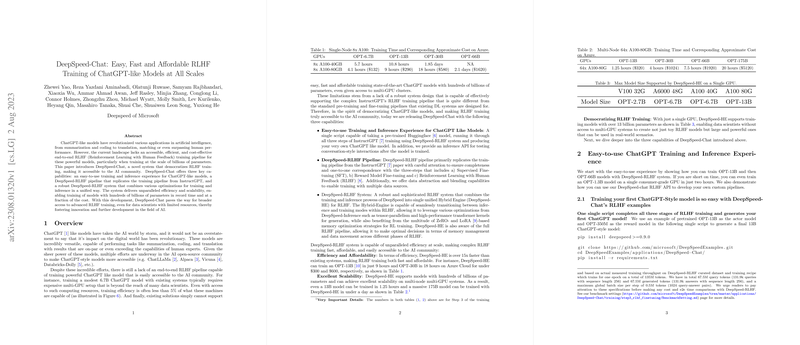DeepSpeed-Chat: A Strategic Advancement in RLHF Training for Large-Scale LLMs
The paper presents DeepSpeed-Chat, a system developed by Microsoft to facilitate the training and inference of ChatGPT-like models using Reinforcement Learning with Human Feedback (RLHF). At its core, DeepSpeed-Chat is designed with the objective of democratizing access to advanced RLHF training methodologies, thereby addressing the prohibitive costs and complexity typically associated with training large-scale LLMs.
Key Contributions
DeepSpeed-Chat introduces significant contributions in three primary areas:
- User-Friendly Training and Inference: It simplifies the model training process by providing an easily implementable interface that allows users to train and deploy ChatGPT-like models. For instance, DeepSpeed-Chat enables the transformation of Hugging Face pre-trained models through an RLHF training pipeline, thereby making cutting-edge AI capabilities more accessible to developers without extensive computational resources.
- DeepSpeed-RLHF Pipeline: The system replicates the RLHF process detailed in the InstructGPT framework, ensuring consistency with recognized methodologies. The training pipeline is comprehensive, covering supervised fine-tuning, reward model tuning, and reinforcement learning stages. Integral to this are data management features that support training across multiple datasets, potentially enhancing model quality and applicability across diverse use cases.
- Hybrid Engine for Enhanced Efficiency: The DeepSpeed-RLHF System integrates a unified hybrid engine (DeepSpeed-HE) which innovatively combines inference and training optimizations. This engine significantly boosts efficiency, with the capability to handle models containing hundreds of billions of parameters, reducing both time and cost for model training markedly. The use of techniques such as tensor-parallelism and memory optimization strategies like Zero Redundancy Optimizer (ZeRO) and Low-Rank Adaptation (LoRA) are critical to this achievement.
Performance and Scalability
The DeepSpeed-HE demonstrates extraordinary efficiency, considerably surpassing existing alternatives such as Colossal-AI and HuggingFace DDP across several metrics. For example, on a single NVIDIA A100-40G GPU, DeepSpeed-HE exhibits over a 10-fold improvement in RLHF training throughput, while scaling to multi-node systems shows substantial speed enhancements, scaling up to models with hundreds of billions of parameters efficiently. Notably, DeepSpeed-HE can sustain training of expansive models like OPT-66B and OPT-175B within highly cost-effective and time-efficient parameters on cloud platforms like Azure.
Impact and Future Prospects
The advancements articulated in the paper have profound implications for both theoretical and applied aspects of AI development. The ability to train LLMs efficiently and affordably accelerates research in AI and broadens the spectrum of entities that can engage in cutting-edge AI development. This democratization paves the way for more small-to-medium sized enterprises, and individual researchers, to contribute significantly to model innovation and application, potentially leading to broader AI adoption across diverse fields.
Future developments could include further enhancements to efficiency, the introduction of additional tools for even more granular customization of the RLHF pipeline, and improved data integration capabilities. Moreover, further studies on the qualitative impacts of models trained using DeepSpeed-Chat could provide insights that feed back into the continuous evolution of training protocols.
DeepSpeed-Chat effectively sets a new standard for affordability and accessibility in RLHF training, allowing for greater experimentation and advancement in the development of complex machine learning models. As the evolution of AI continues, systems like DeepSpeed-Chat will undoubtedly play a pivotal role in shaping next-generation developments.
